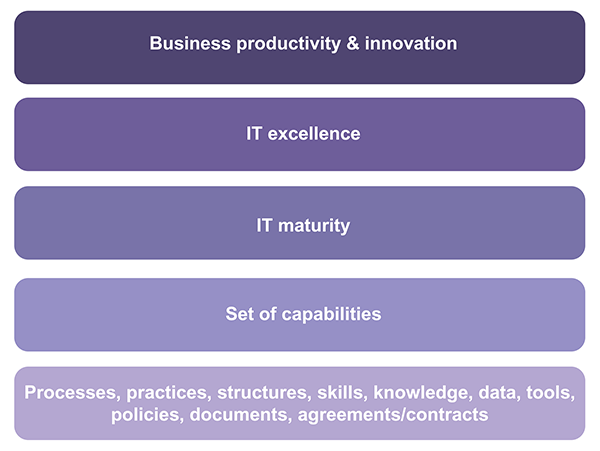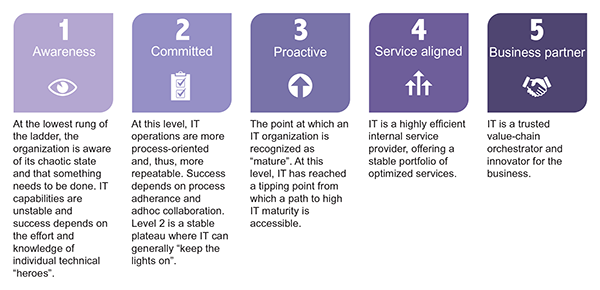In the information age, business performance relies on IT excellence, which in turn relies on IT maturity. IT maturity comprises a set of capabilities—the IT organization’s ability to deliver outcomes. These outcomes are themselves founded on the following:
- Processes
- Practices
- Organizational structures
- Skills
- Knowledge
- Systems, data, tools, policies, documents, and agreements
When we view IT through the maturity lens, we see it as a portfolio of capabilities that can be managed and improved to establish IT excellence—and enable a more productive and innovative business.

So, Just What Is “IT Maturity”?
IT maturity is defined by the collective set of IT capabilities; it’s about what the IT department can do for the business. All businesses are different, so what “good” looks like will vary. Each IT department needs a specific set of capabilities that enable good business performance. Thus, a mature IT organization is relevant to the needs of the business, operates efficiently, and can flex to meet rapidly changing business requirements. Low maturity IT organizations tend to deliver the wrong thing, slowly, and at an unacceptable cost—and fail to adapt quickly when the needs of the business change.
Is High IT Maturity Possible?
Research from analysts shows IT maturity levels have stagnated around halfway up the maturity ladder. Organizations are stuck below a “glass ceiling;” the next step seems out of reach. Most often, it’s not the latest toolset innovations that they need (cutting edge features tend to benefit high maturity IT organizations). Most organizations need to be realistic and focus on the basics; what do we need most. Using an IT maturity model to plot out a path to excellence is all about learning to walk before you learn to run.
Many IT professionals have come to accept constant firefighting as normal—and that average is as good as it gets.

Many IT professionals have come to accept constant firefighting as normal—and that average is as good as it gets. We disagree, because every day we see organizations pushing through this glass ceiling to build more efficient, effective, and agile IT operations. Having said that, only around 10% of all IT organizations self-rank at maturity level 3.0 or above (the point at which Gartner, Inc. considers an IT organization to be mature).

Models and Roadmaps
Having an IT maturity roadmap is a critical success factor to breaking through the glass ceiling and achieving higher maturity. A roadmap will help you structure your journey. Culturally, IT maturity needs to become part of the mindset of IT (and the business)—and IT professionals must shed the idea that average is as good as it can get.
Maturity models often obsess over process maturity, but this is only one aspect. When organizations focus too heavily on process maturity they can exhibit highly developed processes and yet still fail to satisfy business expectations because other aspects of the maturity mix are weak. Gartner’s ITScore for Infrastructure and Operations (ITSIO) model evaluates maturity across four attributes: people, processes, technology, and business practices. The importance of considering all four angles cannot be overstated.
Automation Is Essential in Supporting an IT Maturity Roadmap
IT maturity and IT management technology go hand in hand. To grow and sustain new capabilities in such a complex ecosystem requires automation. Technical problems require technical solutions. Manual collection and processing of infrastructure and operations data simply isn’t possible in anything but the very smallest of organizations:
- Discovering thousands of infrastructure components
- Monitoring real-time system status alerts at a rate of many thousands per hour
- Managing dozens or even hundreds of process flows, many of which cut across teams
- Automating complex service delivery processes that involve integration with multiple system administration tools
- Managing a web and mobile portal for end-users
- Aggregating, analysing, and visualizing metrics and trends, based on millions of data points
- …and many more complex, data-driven and automation-driven use cases that simply cannot be executed manually
Use Your IT Maturity Roadmap as a Frame for Technology Purchase Decisions
Automation of IT operations activity at one maturity level is a critical success factor for achieving the next level, so technology is a necessary part of the puzzle. Organizations must find sufficient efficiencies in their current operating model to create slack, develop new IT capabilities, and take another step up the maturity ladder. Thus, automation is an inherent part of any IT maturity journey.
There are no shortcuts to high IT maturity, but picking the right technology can accelerate your journey. Conversely, the wrong technology can hinder you. As IT organizations grow and mature, the IT management technology on which they rely becomes more complex. With a larger toolset footprint comes a larger application management overhead. IT organizations can become bogged down in administering, integrating, and upgrading a portfolio of management tools instead of focusing attention on pursuing their IT maturity roadmap. This is one reason the Software-as-a-Service (SaaS) sourcing model is becoming so popular—less time managing tools, more time managing capabilities and services.
Poor Technology Buying Decisions Can Stunt IT Maturity
Major changes to toolsets during an IT maturity improvement plan are to be avoided. A rip-and-replace technology migration will not only destabilize current capabilities, but also inhibit forward motion on your path to the next plateau; the IT professionals you need to support projects will be tied up with implementation work.
IT organizations need fit-for-purpose IT management tools. But how can you define what fit for purpose means? The definition depends on your maturity level, so the process must begin with an assessment of current maturity and where the organization wants to go:
- Assess current IT maturity (relative to business need), paying attention to processes, people factors, supporting technology, and management disciplines.
- Devise a clear, prioritized roadmap for developing IT maturity to match up with business demands, taking into consideration any current plans for business growth or transformation.
- Use your roadmap to decide what a fit-for-purpose toolset looks like. Focus IT management technology requirements on what will enable your IT maturity roadmap.
You might think, “We’re under pressure to make major improvements. We don’t have time to assess maturity and then start looking at tools!” The truth is that you don’t have time to do anything else. The overhead of a failed toolset implementation will put you even further away from where you need to be.
Axios Systems is committed to delivering innovative IT Service Management (ITSM) and IT Operations Management (ITOM) solutions that help customers not only improve their infrastructure operations, but also enhance service delivery across business functions, including HR, Facilities Management and Finance. Axios is recognized as a world leader by leading analysts and its global client base, with a 100% focus on service management technologies.